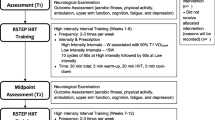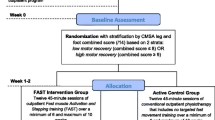Abstract
Objectives
Aerobic exercise can promote neuroplastic responses in the healthy and injured brain. Although the role of exercise in amyotrophic lateral sclerosis (ALS) is debated, new evidence suggests that exercise may reduce disease progression. While common exercise modalities such as the treadmill and cycle ergometer have been explored in ALS, the safety and feasibility of a total body recumbent stepper have not been investigated. Additionally, the functional and neurophysiological effects of recumbent stepping in ALS are still unknown. Here, we investigated the safety and feasibility of a 4-week recumbent stepping program to slow disease progression in ALS and possibly facilitate neuroplasticity.
Method
Nine individuals with ALS performed moderate intensity recumbent stepping for four weeks. Outcomes included participation satisfaction questionnaire, ALS Functional Rating Scale Revised (ALSFRS-R), clinical tests of walking and endurance, fatigue severity scale, Beck depression inventory, SF-12, and transcranial magnetic stimulation-induced motor evoked potentials (MEPs). All measurements were collected at baseline, post-intervention, and at the 1-month follow-up.
Results
Eight participants completed the study without any adverse events. The ALSFRS-R scores were similar at the end of the study and at follow-up. No significant differences were noted for any of the clinical outcomes. MEPs were present only in two participants and changes in corticomotor excitability after exercise were minimal.
Conclusions
Results from this preliminary study support the safety and feasibility of 12 sessions of total body recumbent stepping in individuals with ALS.


Similar content being viewed by others
References
Statland JM, Barohn RJ, McVey AL, Katz JS, Dimachkie MM (2015) Patterns of weakness, classification of motor neuron disease, and clinical diagnosis of sporadic amyotrophic lateral sclerosis. Neurol Clin 33(4):735–748
Zarei S, Carr K, Reiley L, Diaz K, Guerra O, Altamirano PF, Pagani W, Lodin D, Orozco G, Chinea A (2015) A comprehensive review of amyotrophic lateral sclerosis. Surg Neurol Int 6:171. https://doi.org/10.4103/2152-7806.169561
Sinaki M, Mulder DW (1978) Rehabilitation techniques for patients with amyotrophic lateral sclerosis. Mayo Clin Proc 53(3):173–178
Beghi E (2013) Are professional soccer players at higher risk for ALS? Amyotroph Lateral Scler Frontotemporal Degener 14(7–8):501–506
Harwood CA, McDermott CJ, Shaw PJ (2009) Physical activity as an exogenous risk factor in motor neuron disease (MND): a review of the evidence. Amyotroph Lateral Scler 10(4):191–204
Visser AE, Rooney JPK, D'Ovidio F, Westeneng HJ, Vermeulen RCH, Beghi E, Chio A, Logroscino G, Hardiman O, Veldink JH, van den Berg LH (2018) Multicentre, cross-cultural, population-based, casecontrol study of physical activity as risk factor for amyotrophic lateral sclerosis. J Neurol Neurosurg Psychiatry 89(8):797–803. https://doi.org/10.1136/jnnp-2017-317724
Pupillo E, Messina P, Giussani G, Logroscino G, Zoccolella S, Chiò A, Calvo A, Corbo M, Lunetta C, Marin B (2014) Physical activity and amyotrophic lateral sclerosis: a European population-based case–control study. Ann Neurol 75(5):708–716
Huisman MH, Seelen M, de Jong SW, Dorresteijn KR, van Doormaal PT, van der Kooi AJ, de Visser M, Schelhaas HJ, van den Berg LH, Veldink JH (2013) Lifetime physical activity and the risk of amyotrophic lateral sclerosis. J Neurol Neurosurg Psychiatry 84(9):976–981. https://doi.org/10.1136/jnnp-2012-304724
Feddermann-Demont N, Junge A, Weber KP, Weller M, Dvořák J, Tarnutzer AA (2017) Prevalence of potential sports-associated risk factors in Swiss amyotrophic lateral sclerosis patients. Brain and behavior 7(4):e00630
Gallo V, Vanacore N, Bueno-de-Mesquita HB, Vermeulen R, Brayne C, Pearce N, Wark PA, Ward HA, Ferrari P, Jenab M (2016) Physical activity and risk of amyotrophic lateral sclerosis in a prospective cohort study. Eur J Epidemiol 31(3):255–266
Deforges S, Branchu J, Biondi O, Grondard C, Pariset C, Lécolle S, Lopes P, Vidal PP, Chanoine C, Charbonnier F (2009) Motoneuron survival is promoted by specific exercise in a mouse model of amyotrophic lateral sclerosis. J Physiol 587(14):3561–3572
Kaspar BK, Frost LM, Christian L, Umapathi P, Gage FH (2005) Synergy of insulin-like growth factor-1 and exercise in amyotrophic lateral sclerosis. Ann Neurol 57(5):649–655
Liebetanz D, Hagemann K, Von Lewinski F, Kahler E, Paulus W (2004) Extensive exercise is not harmful in amyotrophic lateral sclerosis. Eur J Neurosci 20(11):3115–3120
Veldink J, Bär P, Joosten E, Otten M, Wokke J, Van den Berg L (2003) Sexual differences in onset of disease and response to exercise in a transgenic model of ALS. Neuromuscul Disord 13(9):737–743
Braga ACM, Pinto A, Pinto S, de Carvalho M (2018) The role of moderate aerobic exercise as determined by cardiopulmonary exercise testing in ALS. Neurol Res Int 2018:8218697. https://doi.org/10.1155/2018/8218697
Clawson LL, Cudkowicz M, Krivickas L, Brooks BR, Sanjak M, Allred P, Atassi N, Swartz A, Steinhorn G, Uchil A (2018) A randomized controlled trial of resistance and endurance exercise in amyotrophic lateral sclerosis. Amyotroph Lateral Scler Frontotemporal Degener 19(3–4):250–258
Dal Bello-Haas V, Florence J, Kloos A, Scheirbecker J, Lopate G, Hayes S, Pioro E, Mitsumoto H (2007) A randomized controlled trial of resistance exercise in individuals with ALS. Neurology 68(23):2003–2007
Drory VE, Goltsman E, Reznik JG, Mosek A, Korczyn AD (2001) The value of muscle exercise in patients with amyotrophic lateral sclerosis. J Neurol Sci 191(1):133–137
Lunetta C, Lizio A, Sansone VA, Cellotto NM, Maestri E, Bettinelli M, Gatti V, Melazzini MG, Meola G, Corbo M (2016) Strictly monitored exercise programs reduce motor deterioration in ALS: preliminary results of a randomized controlled trial. J Neurol 263(1):52–60
Merico A, Cavinato M, Gregorio C, Lacatena A, Gioia E, Piccione F, Angelini C (2018) Effects of combined endurance and resistance training in Amyotrophic Lateral Sclerosis: A pilot, randomized, controlled study. Eur J Transl Myol 28(1):7278. https://doi.org/10.4081/ejtm.2018.7278
Erickson KI, Voss MW, Prakash RS, Basak C, Szabo A, Chaddock L, Kim JS, Heo S, Alves H, White SM (2011) Exercise training increases size of hippocampus and improves memory. Proc Natl Acad Sci 108(7):3017–3022
Singh AM, Staines WR (2015) The effects of acute aerobic exercise on the primary motor cortex. J Mot Behav 47(4):328–339
Vaynman S, Ying Z, Gomez-Pinilla F (2004) Hippocampal BDNF mediates the efficacy of exercise on synaptic plasticity and cognition. Eur J Neurosci 20(10):2580–2590
Voss MW, Nagamatsu LS, Liu-Ambrose T, Kramer AF (2011) Exercise, brain, and cognition across the life span. J Appl Physiol 111(5):1505–1513
Petzinger GM, Fisher BE, McEwen S, Beeler JA, Walsh JP, Jakowec MW (2013) Exercise-enhanced neuroplasticity targeting motor and cognitive circuitry in Parkinson's disease. Lancet Neurol 12(7):716–726
Mang CS, Campbell KL, Ross CJ, Boyd LA (2013) Promoting neuroplasticity for motor rehabilitation after stroke: considering the effects of aerobic exercise and genetic variation on brain-derived neurotrophic factor. Phys Ther 93(12):1707
Sanjak M, Bravver E, Bockenek WL, Norton HJ, Brooks BR (2010) Supported treadmill ambulation for amyotrophic lateral sclerosis: a pilot study. Arch Phys Med Rehabil 91(12):1920–1929
Courneya KS, Forbes CC, Trinh L, Sellar CM, Friedenreich CM, Reiman T (2013) Patient satisfaction with participation in a randomized exercise trial: effects of randomization and a usual care posttrial exercise program. Clin Trials 10(6):959–966
Madhavan S, Rogers LM, Stinear JW (2010) A paradox: after stroke, the non-lesioned lower limb motor cortex may be maladaptive. Eur J Neurosci 32(6):1032–1039. https://doi.org/10.1111/j.1460-9568.2010.07364.x
Dalgas U, Stenager E, Ingemann-Hansen T (2008) Multiple sclerosis and physical exercise: recommendations for the application of resistance-, endurance-and combined training. Mult Scler J 14(1):35–53
Rutkove SB (2015) Clinical measures of disease progression in amyotrophic lateral sclerosis. Neurotherapeutics 12(2):384–393
Floyd A, Yu Q, Piboolnurak P, Tang M, Fang Y, Smith W, Yim J, Rowland L, Mitsumoto H, Pullman S (2009) Transcranial magnetic stimulation in ALS utility of central motor conduction tests. Neurology 72(6):498–504
Adami R, Pagano J, Colombo M, Platonova N, Recchia D, Chiaramonte R, Bottinelli R, Canepari M, Bottai D (2018) Reduction of movement in neurological diseases: effects on neural stem cells characteristics. Front Neurosci 12:336
Morris JK, Vidoni ED, Johnson DK, Van Sciver A, Mahnken JD, Honea RA, Wilkins HM, Brooks WM, Billinger SA, Swerdlow RH (2017) Aerobic exercise for Alzheimer's disease: a randomized controlled pilot trial. PLoS One 12(2):e0170547
Alberts JL, Linder SM, Penko AL, Lowe MJ, Phillips M (2011) It is not about the bike, it is about the pedaling: forced exercise and Parkinson's disease. Exerc Sport Sci Rev 39(4):177–186
Briken S, Rosenkranz SC, Keminer O, Patra S, Ketels G, Heesen C, Hellweg R, Pless O, Schulz K-H, Gold SM (2016) Effects of exercise on Irisin, BDNF and IL-6 serum levels in patients with progressive multiple sclerosis. J Neuroimmunol 299:53–58
Schulz K-H, Gold SM, Witte J, Bartsch K, Lang UE, Hellweg R, Reer R, Braumann K-M, Heesen C (2004) Impact of aerobic training on immune-endocrine parameters, neurotrophic factors, quality of life and coordinative function in multiple sclerosis. J Neurol Sci 225(1):11–18
Plowman EK, Tabor-Gray L, Rosado KM, Vasilopoulos T, Robison R, Chapin JL, Gaziano J, Vu T, Gooch C (2019) Impact of expiratory strength training in amyotrophic lateral sclerosis: results of a randomized, sham-controlled trial. Muscle & nerve 59(1):40–46. https://doi.org/10.1002/mus.26292
Funding
This work was supported by the UIC College of Applied Health Sciences Interdisciplinary Grant (SM).
Author information
Authors and Affiliations
Corresponding author
Ethics declarations
Conflict of interest
The authors declare that they have no conflicts of interest.
Ethical approval
All research procedures were in accordance with the ethical standards of the institutional review board and with the 1964 Helsinki declaration and its later amendments or comparable ethical standards.
Additional information
Publisher’s note
Springer Nature remains neutral with regard to jurisdictional claims in published maps and institutional affiliations.
Electronic supplementary material
ESM 1
(DOCX 21.9 kb)
Rights and permissions
About this article
Cite this article
Sivaramakrishnan, A., Madhavan, S. Recumbent stepping aerobic exercise in amyotrophic lateral sclerosis: a pilot study. Neurol Sci 40, 971–978 (2019). https://doi.org/10.1007/s10072-019-03736-3
Received:
Accepted:
Published:
Issue Date:
DOI: https://doi.org/10.1007/s10072-019-03736-3




